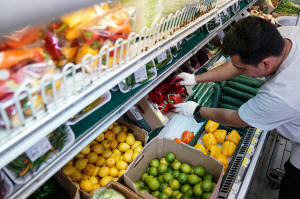Cooling US inflation bolsters September rate cut hopes
 Send a link to a friend
Send a link to a friend
 [July 27, 2024] By
Lucia Mutikani [July 27, 2024] By
Lucia Mutikani
WASHINGTON (Reuters) - U.S. prices increased moderately in June as the
declining cost of goods tempered a rise in the cost of services,
underscoring an improving inflation environment that could position the
Federal Reserve to begin cutting interest rates in September.
The report from the Commerce Department on Friday also showed consumer
spending slowed a bit last month. Signs of easing price pressures and a
cooling labor market could boost the confidence of Fed officials that
inflation is moving toward the U.S. central bank's 2% target. The Fed
will hold its next policy meeting on July 30-31.
"The key question now is whether the positive momentum we've seen over
the last three months will be disrupted heading into the September
meeting," said Olu Sonola, head of U.S. economic research at Fitch
Ratings. "With one eye on recent labor market developments, the Fed is
now likely to use the meeting next week to set the stage for a September
rate cut."
The personal consumption expenditures (PCE) price index nudged up 0.1%
last month after being unchanged in May, the Commerce Department's
Bureau of Economic Analysis reported.
The increase in PCE inflation was in line with economists' expectations.
Goods prices dropped 0.2% after falling 0.4% in May. Prices for motor
vehicles and parts declined 0.6%. Furnishings and durable household
equipment prices dropped for a third straight month, but the cost of
other long-lasting manufactured goods rebounded 1.8%.
Prices for gasoline and other energy goods decreased 3.5% after falling
3.4% in May. Clothing and footwear were cheaper for a second straight
month.

But the cost of services increased 0.2%, matching May's gain. Housing
and utilities costs advanced 0.2%, the smallest increase since March
2023, after rising 0.4% in May. Rents have been one of the key drivers
of inflation. Financial services and insurance costs climbed 0.3%.
Prices for transportation services, however, dropped for a third
straight month. In the 12 months through June, the PCE price index
climbed 2.5%. That was the smallest year-on-year gain in four months and
followed a 2.6% advance in May.
Excluding the volatile food and energy components, the PCE price index
rose 0.2% last month. The so-called core PCE inflation gain was 0.182%
before rounding. May's unrounded figure was revised up to 0.127% from
the previously reported 0.083%. April's core PCE inflation was upgraded
to 0.261% from the previously estimated 0.259% rise.
These upward revisions explain the slightly faster-than-expected
increase in core inflation in the second quarter.
In the 12 months through June, core PCE inflation advanced 2.6%,
matching May's rise. Core inflation increased at a 2.3% annualized rate
in the three months through June, sharply slowing from the 2.7% pace in
May.
The Fed tracks the PCE price measures for monetary policy.
"The much-improved inflation readings indicate that the flare up in
inflation in the first quarter was temporary," said Kathy Bostjancic,
chief economist at Nationwide. "Moreover, if rental inflation has
finally decelerated as recent data suggest, then inflation looks to be
back on a sustained downward trend."
Demand in the economy has cooled in response to the Fed's aggressive
monetary policy tightening in 2022 and 2023. Economic growth averaged
2.1% in the first half of this year compared to 4.2% in the second half
of 2023.
Stocks on Wall Street were trading higher. U.S. Treasury yields fell,
while the dollar was slightly lower against a basket of currencies.
[to top of second column] |

A man arranges produce at Best World Supermarket in the Mount
Pleasant neighborhood of Washington, D.C., U.S., August 19, 2022.
REUTERS/Sarah Silbiger/File Photo

TEPID INCOME GROWTH
The Fed has maintained its benchmark overnight interest rate in the
current 5.25%-5.50% range since last July. It has hiked its policy
rate by 525 basis points since 2022.
Subsiding inflation and easing labor market conditions have led
financial markets to anticipate three rate cuts this year, starting
in September.
Consumer spending, which accounts for more than two-thirds of U.S.
economic activity, increased 0.3% last month after an upwardly
revised 0.4% gain in May, the report also showed. Spending in May
was previously reported to have risen 0.2%. Data for April was also
revised higher.
Spending last month was driven by a 0.4% rise in services,
reflecting increases in housing and utilities, financial services
and insurance, healthcare and international travel.
Goods outlays ticked up 0.1% as a cyberattack at software systems
provider CDK hit operations at several auto dealerships during the
second half of June.
Lower gasoline prices also weighed on receipts at service stations.
But spending on nondurable goods like pharmaceutical and other
medical products rose. When adjusted for inflation, consumer
spending gained 0.2% after climbing 0.4% in May.
With income growth cooling in tandem with a loosening labor market,
consumer spending is likely to remain moderate. Nonetheless, the
pace would probably be sufficient to keep the economy chugging
along.
Personal income rose 0.2% last month after advancing 0.4% in May.
Income at the disposal of households after adjusting for inflation
and taxes nudged up 0.1% after rebounding 0.3% in May, leaving
consumers to tap into savings and also save less.
Wages increased 0.3% after surging 0.6% in May. The previously
reported steady rise in the saving rate over the prior months was
revised away. The saving rate slipped to 3.4%, the lowest level
since December 2022, from 3.5% in May.
Bank of America Securities economists estimated that excess savings
accumulated during the COVID-19 pandemic at around $400 billion and
projected they would last through year-end at the current pace of
rundown.
"Rising savings had suggested consumers were pulling back on
spending and saving more for possibly precautionary reasons," said
Veronica Clark, an economist at Citigroup.

"But spending overall still seems to be slowing with softer than
expected income. If anything, a very low savings rate would suggest
risk of an even sharper pullback in spending as the labor market
weakens."
(Reporting by Lucia Mutikani; Editing by Chizu Nomiyama and Paul
Simao, Kirsten Donovan)
[© 2024 Thomson Reuters. All rights
reserved.]
This material may not be published,
broadcast, rewritten or redistributed.
Thompson Reuters is solely responsible for this content.
 |